Planeswalker's Guide to Bloomburrow, Part 2
We return to the Planeswalker's Guide with part two in the series. Look for the conclusion in part three on July 17, and be sure to check out part one for even more details about the plane and it's animalfolk residents.
The Animalfolk of Valley
The sapient creatures of Valley call themselves animalfolk. Their lives are largely peaceful. They raise families, farm, create art, and explore the world around them. Under their stewardship, Valley thrives, ripe with bountiful nature. Life here is not always easy, but acts of wanton evil are rare. As far as many animalfolk are concerned, the desperate struggle for survival is a matter for the history books.
Communities
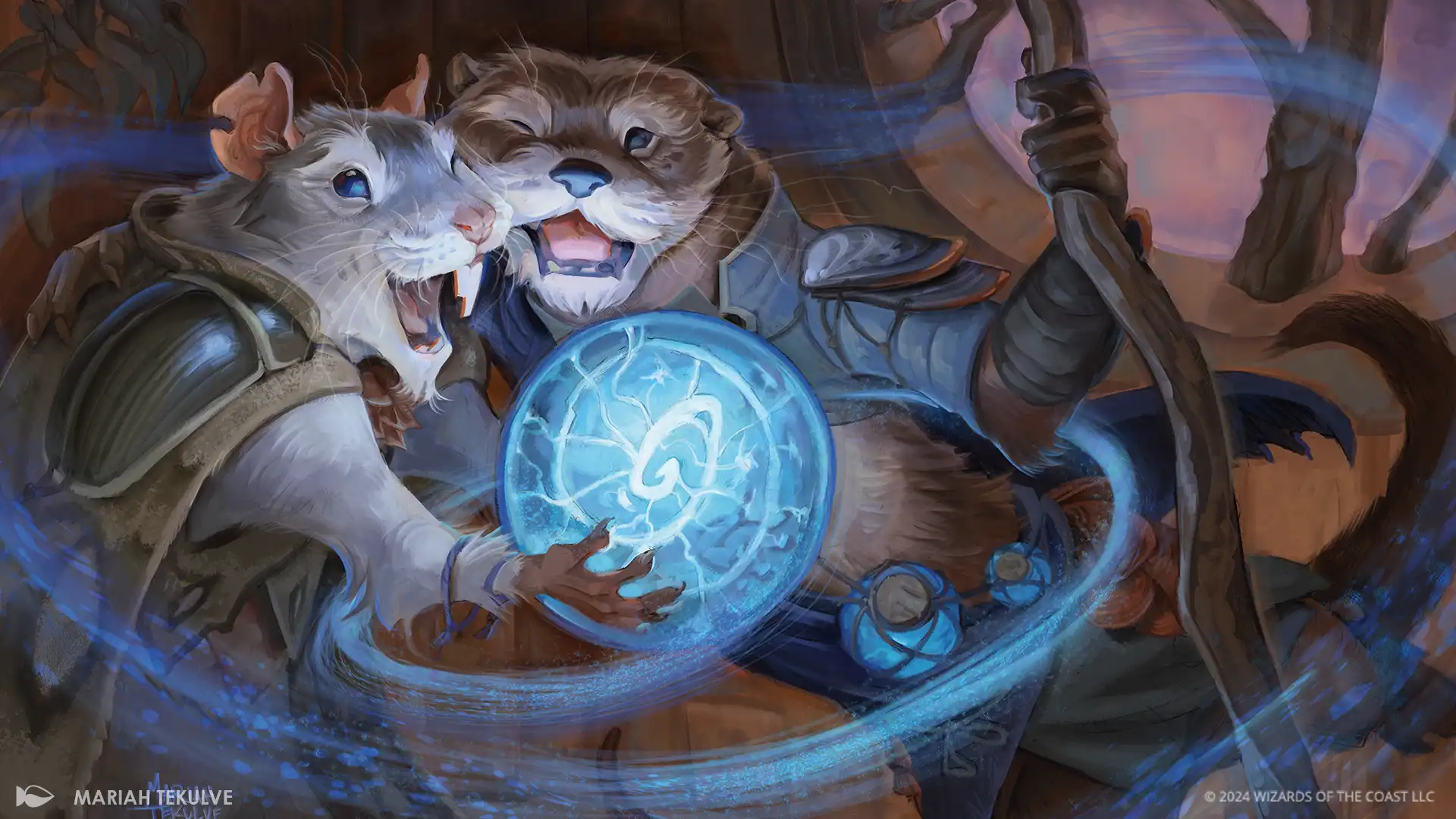
The various species within Valley live, work, and play as a unified people bound by the common goal of prosperity and safety. Animalfolk may live in a hamlet comprised of a single species, a village with species that share similar lifestyles, or large cities with animalfolk from all around Valley. Though different species of animalfolk have their own cultures and traditions that they pass on and preserve, inclusivity is paramount to everyone's success. Animalfolk typically share knowledge freely, whether it be fighting styles, magical traditions, or art forms. Communities tend to consist of animalfolk that live in similar climates and environments, such as squirrelfolk and rabbits in the thickets or otters and frogs among the ponds, but animalfolk of all kinds have founded cities and towns around eclectic mixes of species.
Hamlets, Towns, and Cities
Valley has no single ruler. Typically, authority is delegated to mayors or councils. Each settlement can set its own rules and expectations, but Valley has no overarching culture of law enforcement. Consensus building is the first and often only method of governing. Cities tend to be more striated in their governance, often leaving districts to their own devices, but unlike smaller towns, cities will often have a "king" or single authority figure to make swift decisions. These authority figures are often elected by council or democratically, and typically only serve for a few seasons before relinquishing their power.
Weaving
Spellcasting in Valley is known as weaving and is commonplace, something any animalfolk species can accomplish with effort. Weaving is rooted in nature, drawing power from the world and using that power to manipulate natural forces to some end. Magical traditions are often passed down by parents, elders, or village spellcasters. Animalfolk frequently use their weaving to light their hearths, grow their crops, or patch their roofs. However, when pushed into a corner or properly trained, they can weave magic to augment their weapons, enhance their speed, or siphon their enemy's life force.
The Cuisine of Valley

Animalfolk maintain diverse diets based on their unique needs and physiology. Each animalfolk species has its own unique food culture that favors distinct flavors and ingredients but isn't shy about borrowing from others. Typically, animalfolk are vegetarians, enjoying a robust diet of seeds, nuts, grains, fruits, vegetables, and other nutrient-dense ingredients. Some animalfolk, like the otterfolk, eat fish, while insects are occasionally enjoyed as part of larger meals. These raw ingredients are usually cooked into seasonally distinct meals, such as stews, soups, pies, and salads.
The Industries of Valley
Though Valley might be in tune with the natural world, industry and a spirit of inventiveness is still present. Rather than simply abide by the things in nature, the animalfolk of Valley take it into their own paws (or wings) to improve on the world around them.
Metalworking
The metals of Valley are harvested from trees, melted down, and cast into molds made from seedpods and nut shells. The lizardfolk are masters of this craft, though other animalfolk species have their own method of shaping metal to their needs.
Fabric Making
Fabrics in Valley are primarily made from leaf leather or fabric woven from natural materials like fur or plants and dyed with natural colors. Every species of animalfolk has their own technique for fabric making, though some types of hands make quicker work of the job than others.
Birdfolk 

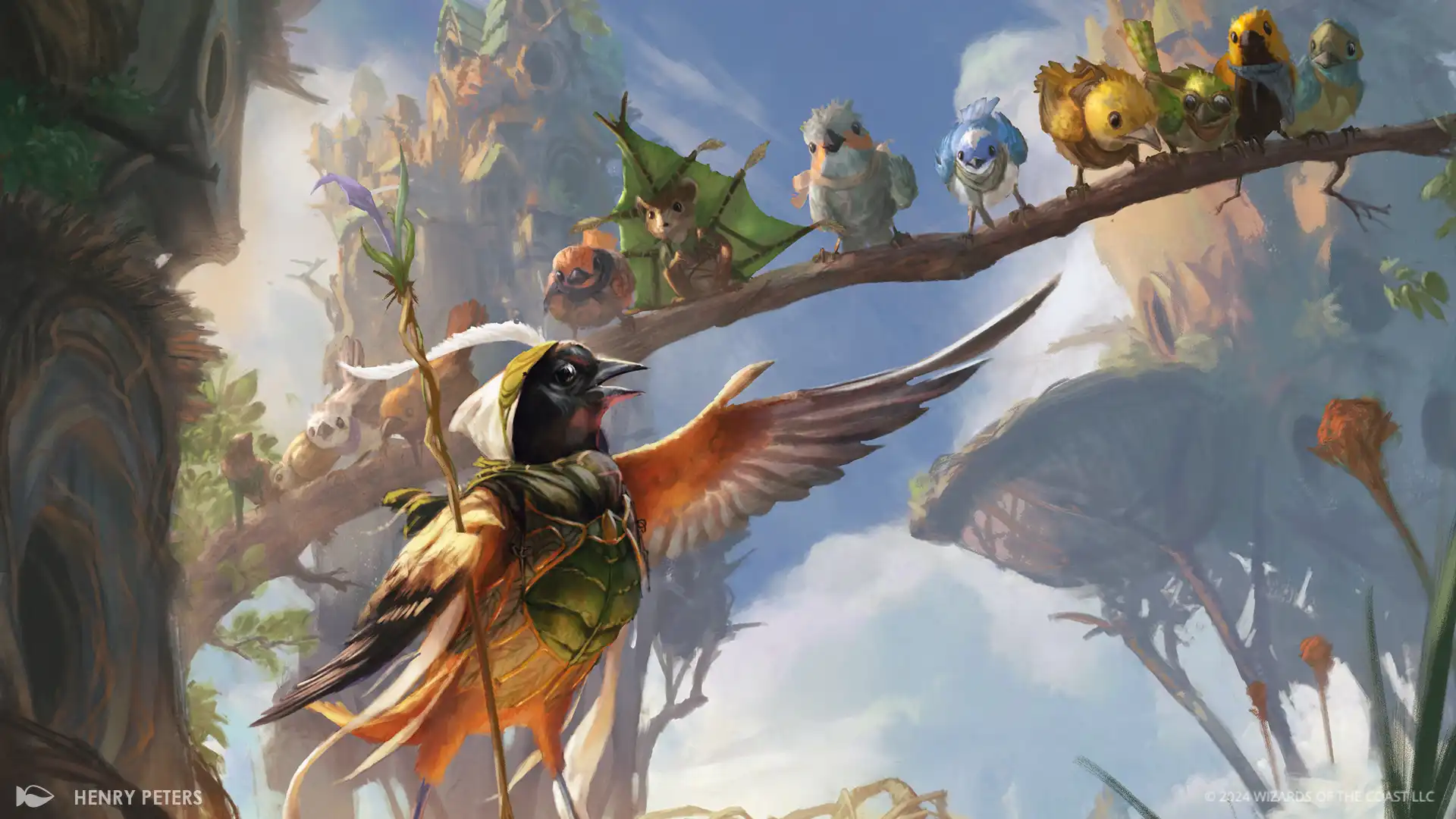
The skies of Valley are home to flocks of birdfolk who are as diverse in coloration as they are in personality. Birdfolk help connect the animalfolk to one another, carrying mail, delivering aid, and even transporting other animals across Valley. At their best, birdfolk are chivalrous, stalwart, and selfless. At their worst, birdfolk are self-important, stubborn, and patronizing.
Typical Personalities
Birdfolk are raised to be staunch idealists. They stick up for those animalfolk that are weaker than them and never look away from injustice, no matter the perpetrator. They see themselves as natural leaders among the animalfolk in Valley, ready to risk their feathers for the sake of equity and peace.
Birdfolk are highly concerned with their physical appearance and social status. They preen their feathers and decorate their outfits to express their personal glories and to reflect their heritage. Birdfolk in larger villages will even congregate at specific times, in bath houses called preeneries, to take a break from their work and keep up their appearances. Though birdfolk care about conforming to these traditions, this doesn't mean that there is no room for individual expression. Birdfolk are encouraged to reflect their unique sense of style so long as they maintain a commitment to service and chivalry.
The Plumecreed
Among the many birdfolk traditions, the most famous and revered is the Plumecreed, a dangerous flight across Valley to reach The Tip of the World, a perilous mountain where no other animals dare to venture. A birdfolk must plant one of their wing feathers at the peak, a sign of their commitment and perseverance, and weave an ancient spell before leaving. The birdfolk who successfully make the journey are blessed with supernatural speed and agility. They are called Windcrested, a testament to their mastery of flight, and often wear a single dyed feather as plumage atop their head to show off their achievement.
Midair Combat
Being gifted with flight changes the way birdfolk fight against Calamity Beasts and other foes. Birdfolk tend to dive from above, either straight down or at sharp angles, carrying a long lance or other polearm. Their attacks are more telegraphed this way but powerful, and multiple birdfolk in combat are difficult to defend against, as they're able to leverage their aerial advantage to cover every angle. Birdfolk weavers can use their flight to quickly save other animalfolk even in difficult terrain. However, birdfolk lack the grounded combat prowess of other animalfolk, so when confined to narrow undergrowth, or when their injuries prevent them from flying, their attacks are clumsy and unpracticed.
Their Role in Valley
Birdfolk are incredibly collaborative and adventurous. They often form adventuring parties alongside other species, where they declare themselves as leaders and assert themselves through grandiose speeches at the beginning of each day. They prefer to take the role of inspiring healers, knightly frontliners, or aerial scouts. Birdfolk make up most of the messengers in Valley, as their flight capabilities allow them to easily avoid ground obstacles and cover long distances. Messenger birds take pride in their work, knowing that communication between Valley's communities depends on their efforts.
Their confidence leads them to find roles as project leaders and diplomats. While they love collaboration, birdfolk enjoy having the final say on issues, often adding to the conversation with long-winded diatribes. While birdfolk remain committed to the larger community that they join, their flair for glory sometimes puts them at odds with other species. A birdfolk might become fixated on accomplishing a task a certain way, to the detriment of their team, convinced that the way things are done is just as important as the result.
Relationships
Birdfolk get along famously with mousefolk, as both are highly adventurous and glory-seeking. Though mousefolk are sometimes brash and reckless, birdfolk can see the burning ideals that motivate their actions and are happy to have a companion who will always be at their side. Frogfolk are culturally more cautious than birdfolk, and their penchant for pessimism, along with their logical, detached attitudes, runs counter to the idealism that drives most birdfolk deeds.
Weaving
Birdfolk magic is primarily for aiding and supporting their allies on adventures. Birdfolk learn magic early on in their lives, typically taught by an elder that they purposefully seek out to learn from. Alongside their academic teachings comes an ethical framework, The Wingbeat Way, which instills a lifelong commitment to use their magic for the common good.
Structures and Settlements
Birdfolk houses are known as Perches. Typically, they are found either high up in trees or on stilts that rise high above the grass, providing good sightlines onto the world below. A home is often passed around between many different birdfolk and their doors are left open to provide immediate shelter for any animalfolk in danger.
Ratfolk 

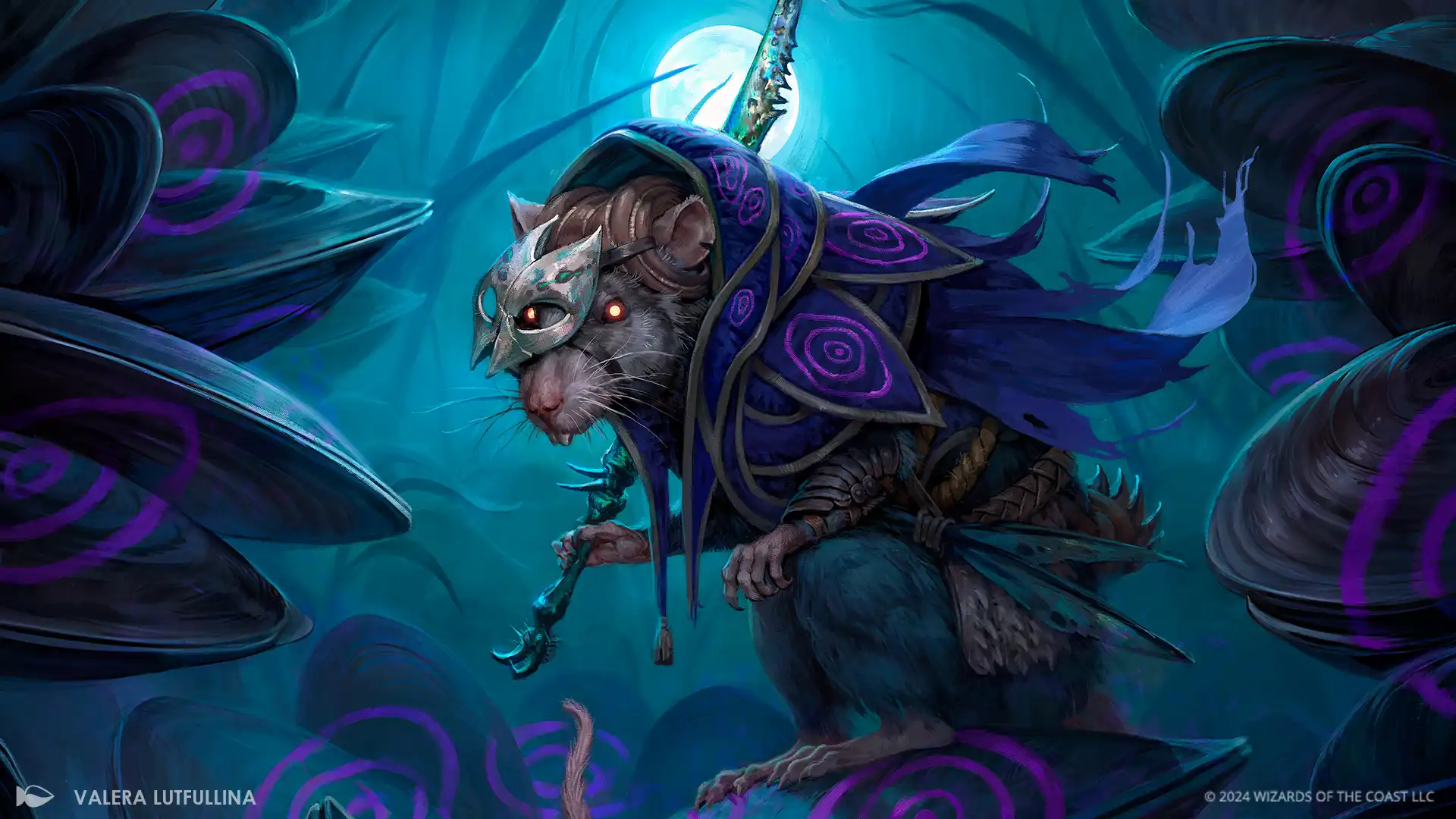
Ratfolk are the secret-keepers of Valley, collectors of relics and knowledge from as early as the foundation of Valley itself. Generations ago, they were more forthright with their knowledge, until a mischievous interloper nearly caused an apocalypse with an unsuccessful attempt to control the Calamity Beasts that caused untold destruction on their home. Because of this misuse of their knowledge, ratfolk society turned isolationist, secretive, and suspicious. At their best, ratfolk are thoughtful, self-sufficient, and intelligent. At their worst, ratfolk are distrusting, dismissive, and uncooperative.
Personalities
Ratfolk are self-reliant and standoffish loners who trust their own skills and have trouble building interpersonal connections with others. Ratfolk typically bond with their insect companions more than the other animalfolk around them. They develop a strong intuitive sense of their insects' needs, but they can become frustrated when others don't share this same understanding. Ratfolk view this behavior as unempathetic.
Because ratfolk tend to be more isolated, they've developed idiosyncratic cultural habits, like talking to themselves or their insect companion, carving shells into sculptures, and meticulously journaling their discoveries to bring back home. When they form bonds with others, ratfolk tend to be clingy and somewhat overbearing, excited to meet someone who shares their interests and/or values.
Valley's Archivists
The Long River that runs down the length of Valley eventually empties out into vast marshlands that the ratfolk call home. The river carries detritus and debris from every place it flows through, a boon to the ratfolk who take these historical treasures and store them away, meticulously documenting their materials, suspected origin, and use. These artifacts are stored in the Knowledge Ossuaries, vast cavernous tunnels below the marshes. Their storerooms contain benign and cataclysmic knowledge in equal measure, hidden away and guarded preciously. Ratfolk call the sum of their knowledge The World Whorl, named for the spiraling pattern that the Knowledge Ossuaries usually take.
Psychic Companions
Ratfolk have gotten used to the rough marshland environments and befriended some of the native insects that have also chosen to live there. Ratfolk might bond with an insect their whole life, developing a psychic link between them through familiarity and magical training. This link can even apply to larger, sapient creatures as well, such as Grotgyre, a snail with hypnotic power strong enough to bend the minds of ratfolk who get close. Typically, ratfolk will train their insect to work as a combat partner, allowing for flanking maneuvers or distractions. Insects can also act as study buddies who can light up pages in the dark or traveling companions on long trips away from home.
Their Role in Valley
Valley's spirit of congeniality means that ratfolk are readily welcomed into conversations and homes, regardless of their isolationist attitudes. Similarly, other animalfolk invited into ratfolk villages are treated with similar hospitality. In conversation, ratfolk choose their responses carefully to share only the most necessary information, without causing confusion.
Ratfolk are resourceful and knowledgeable advisors, librarians, and informants. Recently, more and more ratfolk have ventured outside their sequestered homes to join in larger communities, sharing their expertise and culture with the world. When they come home, they bring new knowledge from Valley to house with their kin.
Ratfolk culture emphasizes skill and expertise, meaning that ratfolk are regarded as excellent partners for adventurers as rogues or mages and as knowledgeable collaborators or artisans. Ratfolk value terseness over verbosity, which can make them come across as standoffish. Similarly, ratfolk culture values reusing clothes, parts, and materials.
Relationships
Ratfolk tend to be fast friends with squirrelfolk since both cultures value recycling and learning from history. While squirrelfolk do tend to be a bit more careless with their valuables, ratfolk can appreciate their resourcefulness. In contrast, the recklessness of lizardfolk and their tendency to destroy their art as part of their "process" is completely antithetical to the value ratfolk place on recording history.
Weaving
Ratfolk are skilled in hypnotic magic, using snail shells as conduits to trick and undermine their unwitting foes. Developed to harmlessly send trespassers away from their knowledge stores, this magic can disguise their approach or escape and is best used when the target is caught unaware. In a pinch, ratfolk can also employ telekinetic powers to help keep their distance and provide distractions.
Structures and Settlement
Subterranean ratfolk homes are more akin to undecorated barracks. Their villages might appear simple at first, primarily made up of rows and rows of capsule-like rooms along the walls where anyone can sleep. However, their plazas and main streets are full of ratfolk culture and artistic expression, reflecting their unique way of life.
Lizardfolk 

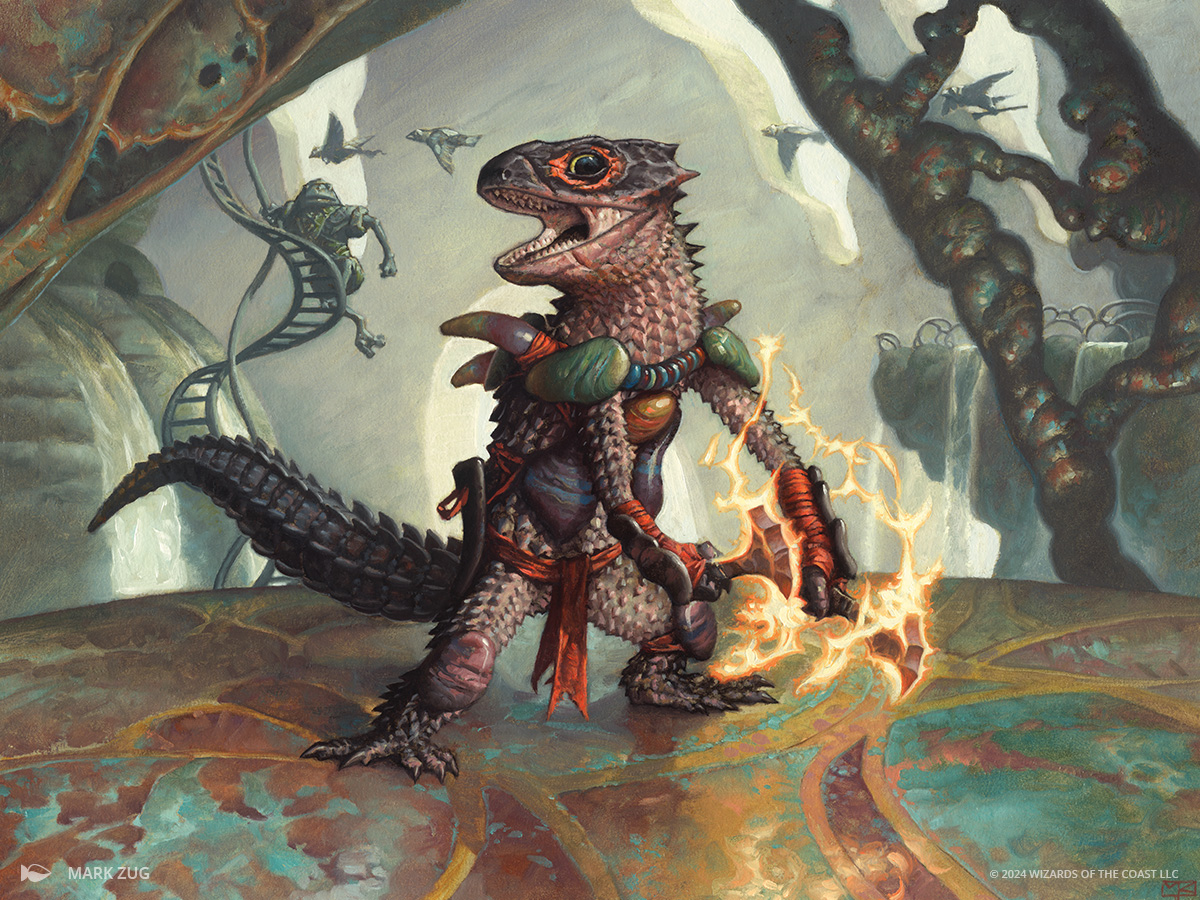
Lizardfolk are the only animalfolk that are not native to Valley. Many seasons ago, lizardfolk populated Valley's few shaley hills and rocky ravines, which best resemble the habitats of their homelands. They are industrious and cantankerous fire-worshippers who live life at their own pace and contribute to Valley as they please. To other animalfolk, they can come across as uncooperative and grumpy, but their enthusiasm and zeal for adventure is the foundation of any great adventuring party. At their best, lizardfolk are passionate, resilient, and direct. At their worst, lizardfolk are moody, aggressive, and cruel.
Personalities
Lizardfolk are gruffer and more standoffish and don't have the same expectations of hospitality and personability that other animalfolk of Valley emphasize. Their different cultural expectations shouldn't be taken as meanness or a lack of empathy, however. Lizardfolk are willing to pitch in any way they can, their actions just lack a veneer of niceness. They might grumble and complain as they help, but the work will get done all the same. Lizardfolk have a love for discovery and excitement, which sometimes comes across as them being neurotic or obsessive when an idea hits, so in some ways you can count on them to always finish the job.
Lizardfolk do tend to hold grudges for a long time, being unforgiving unless real attempts at reconciliation are made. However, once they forgive someone, the incident is never brought up again.
Similarly, favors mean a great deal to lizardfolk culture, and reciprocating favors is an obligation. Lizardfolk view their relationships as transactional in some respects, so owing someone a favor can be stressful or upsetting. The favors don't need to be equally valuable, but something has to be exchanged for their peace of mind.
Due to their cold blood, they typically rest when not performing necessary tasks, storing up energy for later. If a lizardfolk sunbathes too much, they'll get twitchy and overloaded, causing them to rush around erratically as they look for an outlet for their energy.
Artistic Prodigies
Lizardfolk culture encourages artistic expression from a young age, primarily through metalwork, but also with fabrics and paints. Their outlook on art is unique among animalfolk species, as they value not just the creation of art, but also its destruction. Lizardfolk art is meant to decay, fall apart, or be burned, sometimes immediately after its creation. Some monuments will last longer, such as trail markers or large sculptures, but the most important aspect of art in lizardfolk culture is the sense of awe it inspires. Once a community or individual feels bored with their art, they will destroy it and turn their attention to a fresh act of creation, often incorporating pieces of the old art in their new work. In encouraging the creation of something new from something old, lizardfolk see a path to immortality for their culture and traditions. They hope that the spirit behind their art lives on long after their monuments crumble.
Hearthflame
Fire is central to the lives of lizardfolk. Not only does fire have an emotional meaning, but it also functions as heat reserves when sunbathing isn't an option. Every lizardfolk community has a central fire source, whether it is a village hearth, a mystical ember, or a forge. Rituals, like dancing, singing, or just basking in front of their community furnace or the one in their home, are part of everyday lizardfolk life. There is a spiritual nature to this practice, which originated in far-off communities and was brought to Valley. In large villages or cities where lizardfolk live among other animalfolk species, many smaller fire sources will be built instead, so that lizardfolk are never too far away from light and heat.
Their Role in Valley
Lizardfolk are at their element when thick in the fray as either fiery shamans or sneaky assassins. They are not afraid to go at it alone, but they prefer to have some backup that can bail them out or protect them while they rest. Sometimes more combative lizardfolk can become frenzied or bloodthirsty. Their need to expend excess energy stores can cause aggression, even when sparring with a friend.
Most communities rely on lizardfolk firekeepers to keep their flames lit during long winters and rainy seasons. These firekeepers help control the spread of wildfires as well, directing their path to minimize damage to surrounding villages. Lizardfolk also find work as blacksmiths and artisans, passing those skills down to other animalfolk with gruff, dangerous, but ultimately exciting teaching methods.
Relationships
Lizardfolk get along well with batfolk, owing to a shared love of rituals and spiritual practice. Though the species can quarrel at times over the finer details, their mutual respect wins out in the end. Ratfolk value preservation and history, and the idea of lighting art on fire is anathema to ratfolk culture. Because most lizardfolk art is destroyed, the vast libraries of the ratfolk have very few physical remnants from lizardfolk culture, causing a rift in understanding between these species.
Weaving
Lizardfolk magic typically revolves around the use of fire, from lighting torches to casting massive fireballs. Their fire magic can also be used to scorch their foes. Some esoteric lizardfolk arts even allow them to channel venom into their flames, a potent combination that makes even a single strike lethal.
Lizardfolk Structures and Settlements
Lizardfolk homes are built into cliffs or hewn from stone and metal, with flat roofs to encourage sunbathing. No lizardfolk home is ever undecorated, and homes are frequently built around works of art rather than art pieces being created after the fact as decoration. Their most basic decoration can simply be scale-like tiling along the outside of their homes, while their interiors can be lavish, with massive metal sculptures that dwarf the inhabitants.
Raccoonfolk 

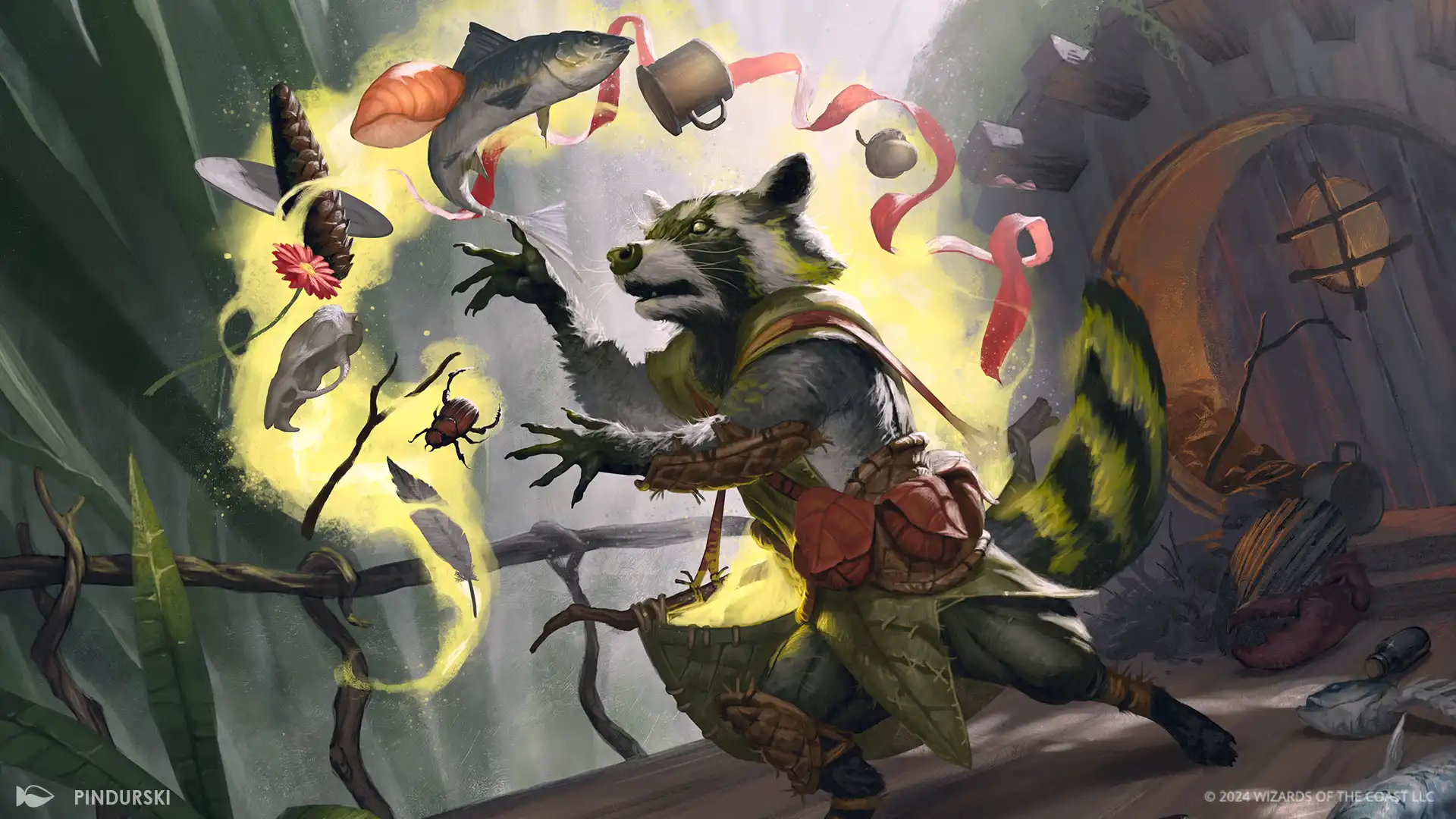
The raccoonfolk of Valley are hoarders, collectors, and wanderers who are just as much at home on the road and in the wild expanse as they are in large villages. Their journeys shape their free-spirited attitudes and love of nature. You'll seldom find a raccoonfolk who would turn down an adventure, no matter the dangers ahead. Other species might see them as flakey, willing to shirk responsibility in favor of excitement, but to raccoonfolk there is no obligation more important than self-discovery. At their best, raccoonfolk are strong-willed, adventurous, and entertaining. At their worst, they are scatterbrained, solitary, and impulsive.
Personalities
Raccoonfolk are natural-born adventurers who value the thrill of discovery that waits around every bend and behind every branch. They'll gladly join others on a journey but will leave just as quickly when they want to move on. Even so, they have strong memories, and even after many seasons away will greet old friends like they had left only yesterday. While their memory is good, their attention span is not. Raccoonfolk tend to miss important deadlines, pursuing a rumor or wandering a path for days, only to return without acknowledgement or apology.
Property and ownership are foreign concepts to most raccoonfolk, who are never surprised to see a guest in their home when they return. They do, however, expect their possessions and history to be treated with respect, often primarily concerned with their collection of trinkets that line their houses walls and pile up in the corners.
Wanderers
Raccoonfolk don't settle down like other animalfolk tend to do. Instead, they live most of their lives on the road, roaming the world at their own pace away from their kinfolk. As a result, they're knowledgeable about locations around Valley and even The Brambles that many animalfolk will never hear about. Most raccoonfolk have an arsenal of incredible stories, neither entirely true nor completely false, based on adventures they've had during their travels. History and culture are passed down orally and haphazardly, resulting in fragmented but colorful traditions that are sometimes completely idiosyncratic to a given location or even individual raccoonfolk.
Mementos and Trinkets
Wherever their paws take them, raccoonfolk bring mementos from their journeys. Often these mementos look like junk, such as broken teapots, shattered weapons, scraps of cloth, or pebbles. These objects stir up memories in their raccoonfolk owners, frequently sparking long sessions of reminiscing and remembrance. Raccoonfolk carry these mementos in magically woven vine knapsacks that can even function as bludgeoning weapons in a pinch, the added weight of their memories causing greater impact.
Racoonfolk Role in Valley
Raccoonfolk hold deep friendships with many other animalfolk species as the free-spirited joy at the heart of raccoonfolk culture melts even the iciest dispositions. Raccoonfolk are often the muscle of a group or a project, owing to their above-average size, or druids who command the elements to defeat their adversaries. With their vast understanding of the different species and cultures around Valley, raccoonfolk often act as adept advisors whose worldly knowledge helps steer projects towards success. And if their advice is no help, maybe a trinket they've found from across the plane will solve the issue.
Being invited to a raccoonfolk's home can mean many things, but it's usually a sign that a going-away party is in your future. A far cry from the delicate dinner parties of other animalfolk, these shindigs start late at night with games, festivities, and lots of food. Once everyone is full, the stories start, with each partygoer expected to pick up where the person before them left off, creating a unique tale that everyone can use to remember their party. Raccoonfolk hosts consider this to be a truly priceless gift.
Relationships
They get along great with otterfolk, as they're both naturally curious risk takers, but the tendency of otterfolk to provoke Calamity Beasts can feel disrespectful to a nature-loving raccoonfolk. The strict hierarchical rules of batfolk society doesn't typically mesh well with a raccoonfolks' drive to follow their own paths, resulting in conflicts between the two cultures.
Weaving
Raccoonfolk magic typically involves manipulating discarded materials many would consider "junk", using it for projectiles or barriers. Raccoonfolk of prodigious skill learn to use their magic to empower themselves and the natural world around them, weaving knots from plant matter and imbuing them with energy. A druid might magically grow their staff to encase objects so that it can serve double duty as both a carrying device and a weapon. Extremely skilled raccoonfolk druids can even animate the surrounding environment into natural defenses.
Raccoonfolk Structures and Settlements
Raccoonfolk homes tend to be built into the bases of trees, with big round doors and a warm fireplace that fills the room with its glow whenever they are home. Though these homes can appear haphazardly constructed to other animalfolk, in reality they are sturdy structures that can last for generations. Frequently, these houses are less "dwellings" and more "storage units" where raccoonfolk hoard the countless trinkets and trophies they've gathered from their travels. Clutter is expected, and raccoonfolk moving into a new home will "break it in" by scattering piles of junk around. Raccoonfolk will reuse a house after its current owner has abandoned it, leaving their previous owner's decorations up and adding their own.
Rabbitfolk 


Rabbitfolk are talented chefs and industrious farmers who provide the bulk of Valley's food. Though they have a reputation for being boring homebodies, every species in Valley respects the hardworking rabbitfolk who keep their tables full. At their best, rabbitfolk are stalwart, hospitable, and peaceful. At their worst, they are stubborn, narrowminded, and cowardly.
Personalities
Rabbitfolk culture values working with the earth, emphasizing respect for nature and its blessings. Their conflict-averse nature means they work well with other animalfolk, if only because they prefer to let problems blow over rather than confront them directly. Rabbitfolk are highly efficient and organized, to the point that rabbitfolk will show up early to appointments or dinners in an attempt to outdo one another in politeness. This can become a problem as rabbitfolk continue to arrive earlier and earlier. In extreme cases, rabbitfolk have been known to show up first thing in the morning for a party that starts later that night.
Rabbitfolk value simple ideas and easily articulated values. Complex issues without clear solutions can cause them to either freeze up in indecision or avoid the situation entirely. Though they tend to be unambiguously hospitable and attentive, articulating why they behave a certain way often comes down to, "It's the way it should be." Gifts in rabbitfolk communities can be lavish, not simply in terms of financial value but in terms of volume. Being able to give generously is an expectation, showing that you and your family or community are safe and prosperous, even when it might not be true.
Rabbitfolk who venture to the big city usually still maintain their familial ties, visiting often and leveraging their position to help support their home. They are always willing to lend a helping paw to others, often with no expectation that they'll be compensated. Other animalfolk take advantage of this habit and this exploitative attitude might go over the rabbitfolk's head.
Families and Farming
Family and community are paramount to rabbitfolk society. Many rabbitfolk live their entire lives within their communities, never leaving their small village except to sell produce or other goods at the market. Rabbitfolk lives revolve around their large families, called Fluffles, and their homesteads. The eldest rabbitfolk in the family are the de facto arbiters of the household, held in high esteem by their children, grandchildren, and great-grandchildren. Very seldomly, rabbitfolk will leave their village entirely to make a life for themself in a larger village or city. Those who move away typically find themselves adopted into rabbitfolk communities wherever they're going. Other times, they might find another group of animalfolk that they can dote upon.
The Pawpatch Party
Though rabbitfolk are typically pacifistic, they will still staunchly protect their homes and lands. The most dedicated rabbitfolk can join the Pawpatch Party, a group of powerful and adeptly trained warriors who patrol Valley to protect from Calamity Beasts. These rabbitfolk are known for their antler helmets and large, metal-coated weapons and shields. Members of the Pawpatch Party are renowned for their skill and perseverance, owing in no small part to their excellent provisions.
Their Role in Valley
Rabbitfolk chefs are renowned for their cooking, which is largely considered unrivaled by other animalfolk. Highly meticulous and dedicated, rabbitfolk are diligent workers with excellent hospitality skills, and are highly sought after to help run inns. Their connections with other rabbitfolk villages means that they can be counted on to procure the freshest ingredients, attracting patrons to their doors.
When out adventuring, rabbitfolk typically serve as clerics, healing their friends or casting great boons on them. Some of the bravest and brawniest rabbitfolk take work as front-line warriors who can pack a serious wallop when needed!
Relationships
Rabbitfolk and mousefolk both come from large families and are strong partners in both the field and the city. Their love of home cooking means that they often exchange dinner party invitations, even if mousefolk sometimes struggle to provide enough food for the much larger rabbitfolk. When it comes to relationships, rabbitfolk and lizardfolk are opposites. The tendency of lizardfolk to be confrontational, blunt, or standoffish is stressful to the mild-mannered rabbitfolk.
Weaving
Rabbitfolk magic is used to support farming, growing plants, and restoring life to the vegetation around them. Their growth magic can even cause plants to become supersized.
Rabbitfolk Structures and Settlements
Rabbitfolk houses are often built directly into the ground, with long burrows underneath and tall windmills on top. Rabbitfolk structures, more so than other animalfolk dwellings, blend into their environments. They also serve as silos and mills to limit the impact on their surroundings.
Preorder Now
Bloomburrow arrives August 2, and you can preorder products now through your local game store, online retailers like Amazon, and where Magic: The Gathering products are sold.


